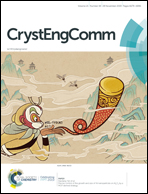Study on the photoelectrocatalytic performance of a WO3 thin film electrode by constructing a BiOI/WO3 heterojunction
Abstract
To address the shortcomings of the narrow solar absorption range of WO3 thin film electrodes and the high recombination rate of photogenerated electrons, a WO3 thin film electrode containing a BiOI/WO3 heterojunction was constructed using simple hydrothermal and electrodeposition methods. The photoelectrocatalytic activity was investigated through the degradation of methylene blue (MB) solution. By controlling the electrodeposition time, BiOI/WO3 thin film electrodes with different BiOI contents and morphologies were obtained, and the electrodes were subjected to X-ray diffraction (XRD), scanning electron microscopy (SEM) and X-ray photoelectron spectroscopy (XPS). In addition, the photoelectrochemical properties of different electrodes were studied by electrochemical impedance spectroscopy (EIS), photoluminescence (PL), photocurrent, Mott–Schottky and other test methods. The results show that the BiOI/WO3-120s thin film electrode achieves the best photoelectrocatalytic activity, with an electrodeposition time of 120 s and an applied voltage of −1.0 V. The efficiency of the photoelectrocatalytic degradation of MB by the BiOI/WO3-120s film electrode can be as high as 86.7%, which is 3.6 times the photoelectrocatalytic degradation efficiency of a pure WO3 film electrode. The increase in the photoelectrocatalytic activity is ascribed to the heterojunction structure formed by the combination of BiOI and WO3. The heterostructure photocatalytic electrode significantly improves the electron transport performance of photogenerated electrons and holes and reduces the band gap of the WO3 electrode and photogenerated electron–hole pair recombination probability while expanding the solar absorption range of the electrode. The detailed mechanism of the photoelectrocatalytic performance of the BiOI/WO3 heterojunction on the WO3 thin film electrode is also discussed. This study provides a novel theoretical basis for the development of high-performance WO3 photocatalytic materials.



 Please wait while we load your content...
Please wait while we load your content...